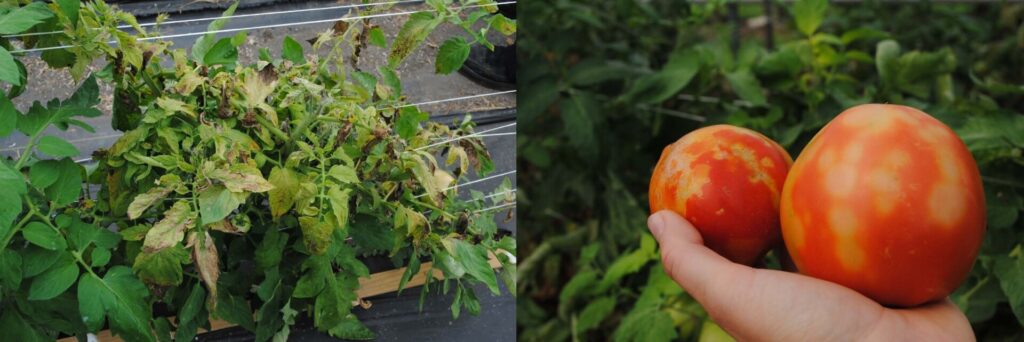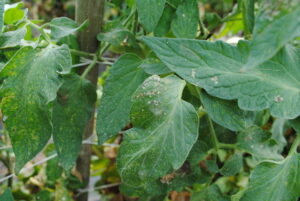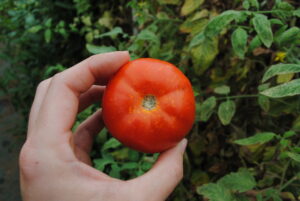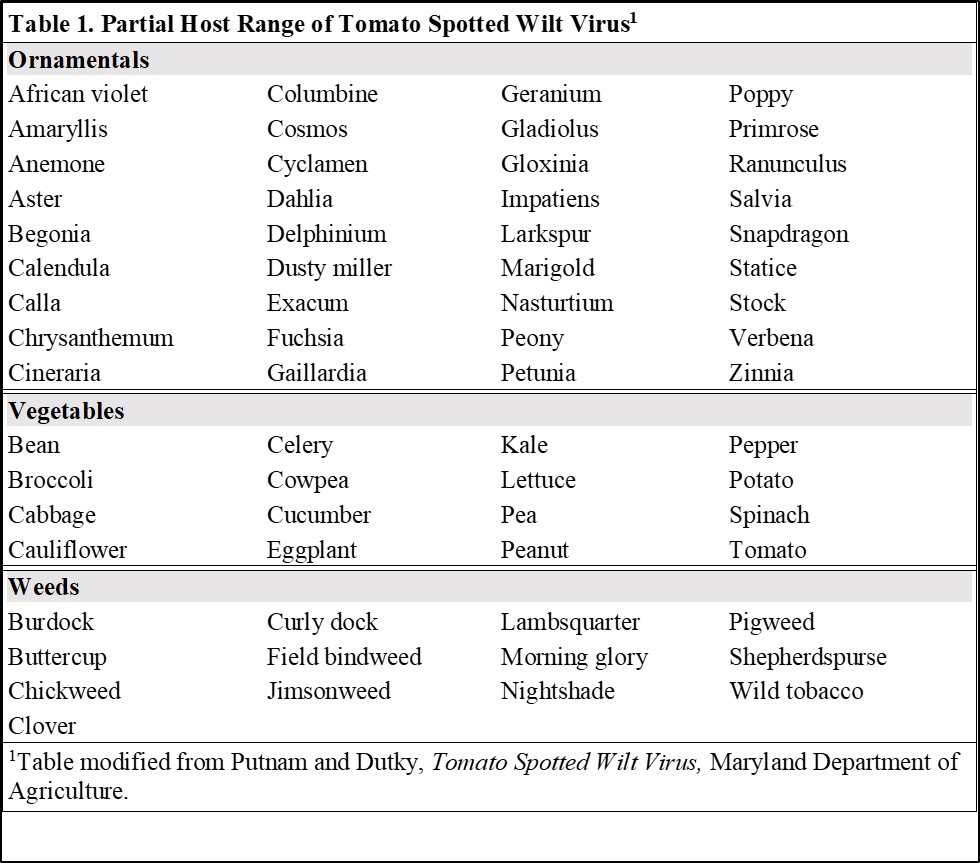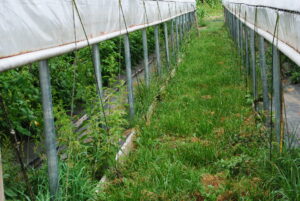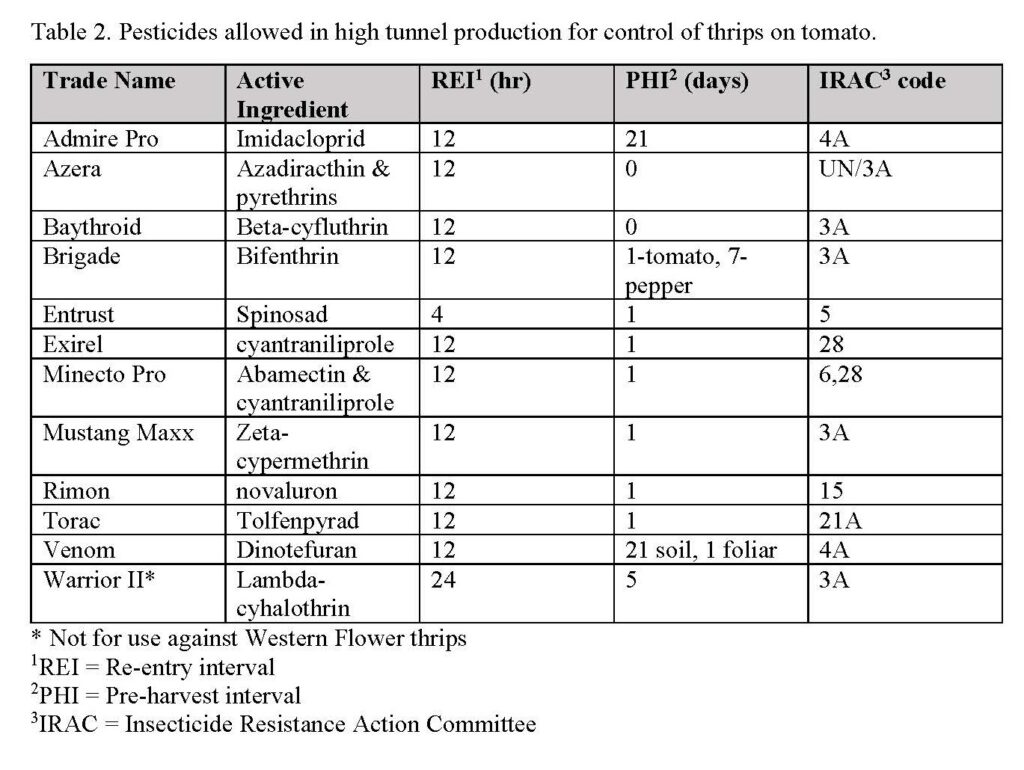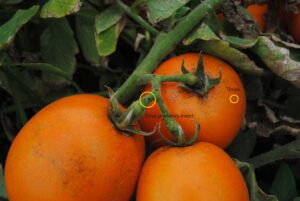Tomato spotted wilt virus (TSWV) is a plant disease caused by a virus that infects more than 1,000 species of plants, including ornamentals and vegetables. Visual symptoms of TSWV vary depending on the plant that is infected, but general characteristics include yellow or brown ringspots on fruit and small, dark-colored ringspots on foliage that may make the entire leaf appear bronzed in severe cases (Figure 1). The virus is moved (vectored) from plant to plant by the piercing-sucking feeding of tiny insects called thrips. So, managing this disease requires strong and continued efforts to: (1) manage the source of the virus (other plants that are already infected), and (2) manage thrips, which move the virus from infected plants to healthy plants.
The insect that moves TSWV from plant to plant: Thrips
1. Thrips feed on plants by puncturing the outer layer of leaf cells and sucking up the contents, which results in silvering, stippling, and discolored flecking of the surface (Figure 2 and 3). Thrips feeding may also cause leaves and flowers to be deformed in appearance.
2. Larval (immature) thrips are the only life stage that can acquire (“pick up”) TSWV when they feed on infected plants, but adult thrips are the only life stage that can transmit (spread) the virus to new plants. This means adults can only infect healthy plants if they fed on an infected plant as a larva. TSWV is not transmitted vertically from adult thrips to offspring.
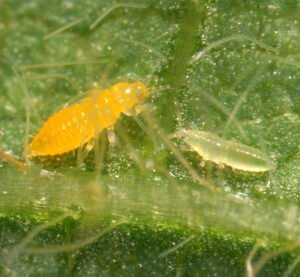
Figure 4. The two nymphal stages of thrips: smaller, first instar (on right) and larger, second instar (on left). Photo credit: John Obermeyer.
3. Thrips lay their eggs inside leaves or flower petals where they are difficult to reach with insecticides. Once eggs hatch, the larvae often remain in protected areas, like inside flower buds or within leaves at the top of the plant. After two larval stages (Figure 4), thrips move down to the soil or leaf litter and enter a pupal stage where they are inactive (no feeding and almost no movement) (Figure 5). During this phase, the insects are not managed by insecticides that are directed at the leaves. Adult thrips live for 30-45 days and can lay 150-300 eggs. The development from egg to adult ranges from 7.5 – 13 days depending on temperature; warmer temperatures = faster development.
4. Several species of thrips transmit TSWV, but the most important ones are the western flower thrips, tobacco thrips, and onion thrips. Because thrips are so tiny, they can be carried by the wind from surrounding areas or on your clothing as you move from outdoor to indoor environments.
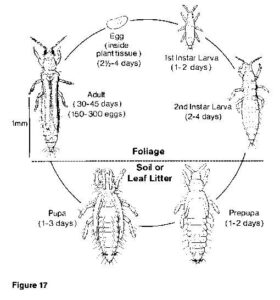
Figure 5. Diagram of the thrips life cycle. Image adapted from https://www.vegetables.cornell.edu/pest-management/disease-factsheets/
Keeping TSWV out of your greenhouse
1. Start with healthy, virus-free plants and inspect all incoming plant material for TSWV symptoms and thrips infestation. Vegetatively-propagated ornamentals can be an important source of TSWV! For example, you could accidently introduce TSWV into your greenhouse from propagated plants or transplant seedlings that are already infected, then once thrips arrive, they will spread the virus to other plants in the greenhouse. Do not buy vegetable starts that are produced in the same greenhouse as ornamentals. Seed transmission is not considered important for spread of this disease.
2. Manage weeds, both inside and around your greenhouse because they are an important source of the virus each year (Table 1). Many perennial ornamentals and weeds can be infected by TSWV and these plants can become a source of the virus at any given time during the current or following year.
3. Once TSWV is confirmed in your greenhouse, remove and destroy all infected plants because they cannot be cured and will serve as a source of new infections.
What to do RIGHT NOW
Although the growing season is winding down, you still need to keep your guard up, especially in controlled environments.
1. Sanitation! Remove and destroy all plant material from this year’s crop promptly, as soon as you are done harvesting. This is especially important if you have confirmed TSWV and thrips in your crop. Physically remove all old crops from controlled environments and destroy them away from the controlled environment by plowing, disking, etc. Whether a field or controlled environment, allow ground to lay fallow for 2-3 weeks if possible to break the life cycle of any remaining thrips.
2. Manage (i.e. remove) all weeds within and around the space (Figure 6). Almost all of the weed species that are commonly encountered in Indiana can host these pests, and many of these weeds have been reported to host the virus as well, including nightshade, morning glory, lambsquarter, clover, chickweed, and the list goes on (Table 1). Any weeds that overwinter in your high tunnel or greenhouse have the potential to host both the insects and the pathogens they transmit. Remove the weeds and leave the structure open throughout the winter if possible.
To Prepare for Next Year
1. Variety selection can be key for managing TSWV. If possible, select a tomato variety that is resistant to this virus.
2. Look at your insecticide regime and be sure that you are rotating products. Thrips and mites both develop resistance quickly to insecticides. It may be necessary to invest in some different products to break the thrips life cycle. Be sure that you refer to the IRAC code (Insecticide Resistance Action Committee). These codes have been established, in part, for growers to easily select chemistries that have different modes of action (in other words, the way it works to kill the pest). To reduce the development of resistance, do not make more than two applications of the same product (IRAC code) in a row. Table 2 is a list derived from the Midwest Vegetable Production Guide (mwveguide.org) with insecticides that are allowed for high tunnel/greenhouse use in Indiana.
3. Consider incorporating a beneficial organism to prey on the soil-dwelling stages of thrips. This should be considered in the off-season as it will take time to find a supplier and determine their ordering and shipping deadlines. You should plan to incorporate these organisms early in the season (prior to, or at the first sight of thrips). Two commonly available options include predatory soil-dwelling mites (Stratiolaelaps scimitus) and entomopathogenic nematodes (nematodes that eat insects, Steinernema spp.). Chemistries such as novaluron, spinosad, tolfenpyrad and acetamiprid applied in the soil as a drench or drip are compatible with the predatory mite species (i.e. the chemical won’t destroy the population of beneficial mites). Bifenthrin, imidacloprid and lambda-cyhalothrin have been reported as non-toxic and safe to use with entomopathogenic nematodes. Various suppliers of beneficial insects have an interactive tool on their website to look at the impacts of a chemical product on the beneficial organism.
4. Using reflective mulches under plants can reduce TSWV infection by repelling thrips.
During the Growing Season
1. Monitor for the presence of thrips by placing yellow sticky cards just above the crop canopy (Figure 8 and 9). It is recommended to place 1 sticky card per 1000 square feet, as well as near doors and air vents to monitor the movement of thrips from outside. Check sticky cards every week and record the number of thrips captured to monitor population levels and inform management decisions.
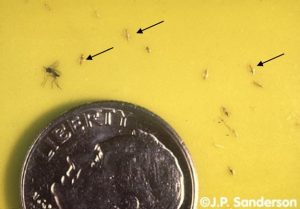
Figure 8. Several thrips (designated with arrows) captured on a yellow stick card. Image from Cornell University, J. P. Sanderson
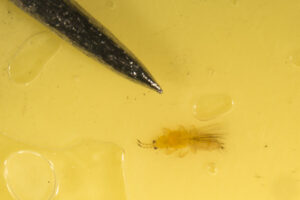
Figure 9. Close up of adult thrips captured on a yellow sticky card. Photo by John Obermeyer.
2. Spray insecticides in the morning, when thrips are most active. Five-day insecticide application intervals are more effective than 7-day intervals in reducing thrips infestation. Follow a rotation plan when applying insecticides to prevent the development of resistance.
3. Follow the label closely. Many products kill the insect by coming into contact directly so adequate coverage and rates of application are crucial to get the most out of a product. If possible, apply insecticides with equipment that produces very small spray particles that will penetrate foliage and flowers to provide the best coverage. Note: Some insecticides may damage certain plants so please read and follow all label instructions
4. Protect plants early, when they are young and most vulnerable which is also when thrips populations tend to be lower and you have a better chance of getting them under control.
5. Continue to manage weeds. They can be a continuous source of pests (the insects and the virus) during the growing season, either between planting dates or even between applications of a chemical.
6. For TSWV in particular, if infection rates are low (only a few plants) and it is early in the season it is advantageous to remove infected plants to reduce the spread of the virus.
7. If feasible, install exclusion netting. The number of thrips entering a greenhouse may be greatly reduced by covering the doors and air intakes with a fine mesh (400 mesh) cloth.
